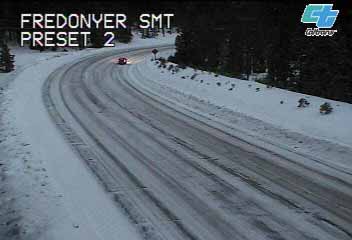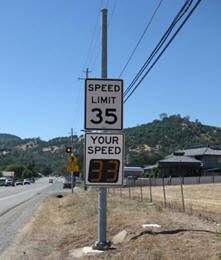California Oregon Advanced Transportation Systems (COATS) Phase 6
The COATS effort was built on a long-term partnership between Caltrans, the Western States Rural Transportation Consortium (WSRTC) and the Western Transportation Institute at Montana State University (WTI) to explore and address the challenges facing rural ITS. COATS Phase 6 will use this ITS and institutional knowledge of stakeholders in the region, combined with technology transfer activities from the Western States Forum and incubator projects identified by the Project Technical Advisory Panel (PTAP), to continue successful demonstration and evaluation of ITS technologies in that context. The following tasks were slated for completion during COATS Phase 6:
Western States Rural Transportation Technology Implementers Forum (WSRTTIF)
The annual Forum, a meeting focused on providing technology transfer and networking opportunities for professionals working in design, implementation, and maintenance of ITS technologies in rural environments, will continue during this phase of COATS. The Forum was conceived to enable ITS practitioners to reap the same benefits of information sharing that ITS planners in the COATS region had been realizing through the COATS project. It is unique nationally with respect to its participants, format, and technical content, and its origin and development reflect the idea of using COATS as an incubator for innovations in the use of technology to address rural transportation challenges.
Go to the Forum website for the agendas, technical content, and photos from the 2015 and 2016 Western States Forums.
Year 1 Incubator Projects
During the first year of the COATS 6 effort, the research team examined two incubator projects, low-cost research efforts that serve as a “proof of concept” to potentially develop into a larger effort in the future or answer research questions in a limited scope. These incubator projects are described below.
Technology Incubator: Data Quality for Aggregation and Dissemination of DOT Traveler Information: An Analysis of Existing System Best Practices
The quality of data is a crucial consideration for the provision of meaningful traveler information. It has generally been handled on an ad-hoc basis, with little or no provision for error notification other than perhaps through user-reporting of observed errors. The goal of this technology incubator project was to analyze and document existing system best practices for data quality for the aggregation and dissemination of state department of transportation traveler information. The research team conducted a survey of DOT practitioners in western states, as well as a literature review on data quality within the transportation field.
At the onset of the task, it was recognized that there may not be any so called “best practices” established for traveler information data quality. Neither the survey of DOT practitioners nor the literature review found a comprehensive, well-defined plan for unified, multi-dimensional approaches to quality assurance of traveler information. However, all of the DOT practitioners that were surveyed, as well as the literature reviewed relative to data quality in transportation, indicated in some way that quality data was important for safe, efficient operation of the transportation system, including provision of traveler information that is accurate, timely, and reliable. This observation is especially valid given the current environment that is increasingly focused on performance measurements, accountability and “smarter” operation of roadways.
Procedures and considerations relative to data quality were documented from the literature and the DOT practitioner survey. For example: automated sensor tests, maintenance and calibration, data sampling, well-defined measures and standards, operator observations, user error reporting, etc. Recommendations and next steps were made specific to Caltrans traveler information data and processes.
To review the final research task report click here, or go to the COATS project Documents page. The report can also be found on the COATS Phase 6 documents page along with other project related work.
Safety/Operations Incubator: Evaluation of the Fredonyer Summit Icy Curve Warning System –Before and After Study of Long-Term Effectiveness
The Fredonyer Pass Icy Curve Warning System (ICWS) is a Caltrans project designed to increase motorist vigilance and to reduce the number of crashes occurring when pavement conditions are icy. Using a combination of pavement sensors, RWIS data, and dynamically activated signage, the ICWS alerts motorists of icy conditions on the Fredonyer Pass in real-time. The dynamic warning system allows drivers to adjust their speed in preparation for road conditions further ahead, which is expected to reduce crash rates along the curves of the Pass. The Caltrans CCTV images below show potentially icy road conditions on Fredonyer Summit.
 |
 |
For this safety/operations incubator project, the research team evaluated the effectiveness of the Fredonyer ICWS with a focus on speed reduction under various conditions and safety performance through crash reduction. The study’s results suggest that the warning system is working as intended, with an average decrease in motorist speeds and a resulting 15% reduction in annual crash rates while operational. Additionally, the results indicated that the ICWS reduced crash severity as well. Since its full deployment in 2008, the system was estimated to have provided $1.03 million dollars of safety benefit per winter season through the reduction in crash frequency and severity.
Detailed results, conclusions, and recommendations from the project can be found in the final report document – Evaluation of the Fredonyer Pass Icy Curve Warning System. The report can also be downloaded from the COATS Phase 6 documents page and the WSRTC’s document archive. This evaluation and other documents related to the COATS project can be found on the COATS Documents page.
Year 2 Incubator Projects
Bluetooth Evaluation for Siskiyou Summit Chain-Control Chain-Up Area North of Redding
For this incubator project, the research team will utilize Bluetooth readers to develop a preliminary prototype algorithm to predict delays through a chain-up area.


For COATS Phase 5, recommendations were made regarding prospective locations for deploying Bluetooth readers relative to the Fawndale chain-up area. The sites were prioritized based on the assumption that between three and eight Bluetooth readers would be deployed in order to provide sufficient data to accurately determine delay. The task was continued in COATS Phase 6 and work included identification of Bluetooth readers that could potentially be deployed for this application. The project team determined that the most important criteria for Bluetooth readers for this application were availability of raw data (MAC addresses and timestamps), long detection range, and no requirement for cellular data service. Other useful options were WiFi reader capability and a GPS receiver.
Further work on this task was deferred to a subsequent COATS project phase pending deployment of Bluetooth sensors in proximity to the chain-up area. For more details about the potential deployment locations and Bluetooth reader sources/vendors, refer to the recommendations and sources report – Chain-up Delay Tracking with Bluetooth: Prospective Deployment Recommendations and Sources for Bluetooth Readers.
Check back on the COATS project pages for more information about this project in the future.
Long-Term Operational and Safety Impacts of Radar Speed Signs
The intent of this research task was to perform an evaluation of the long-term effects on crashes and speed trends of Radar Speed Signs using historical data from existing, permanent sign locations in California. Per guidance from the project manager and the PTAP, this task was deferred potentially to a subsequent phase of the COATS project. This was done in order to focus resources on Task 4, which included the evaluation of the Fredonyer Pass ICWS and identification of best practices for traveler information data quality.

Outreach
PTAP committee members presented at and attended the National Rural ITS (NRITS) conference and the 2016 Northwest Transportation Conference. Results to date of the traveler information data quality incubator project task were presented at the 2015 NRITS conference. In addition, five PTAP meetings provided an opportunity for discussion of current and future ITS activities in the region.
The final report for COATS Phase 6 can be reviewed here. The report can also be found on the COATS Phase 6 documents page along with other project related work.

